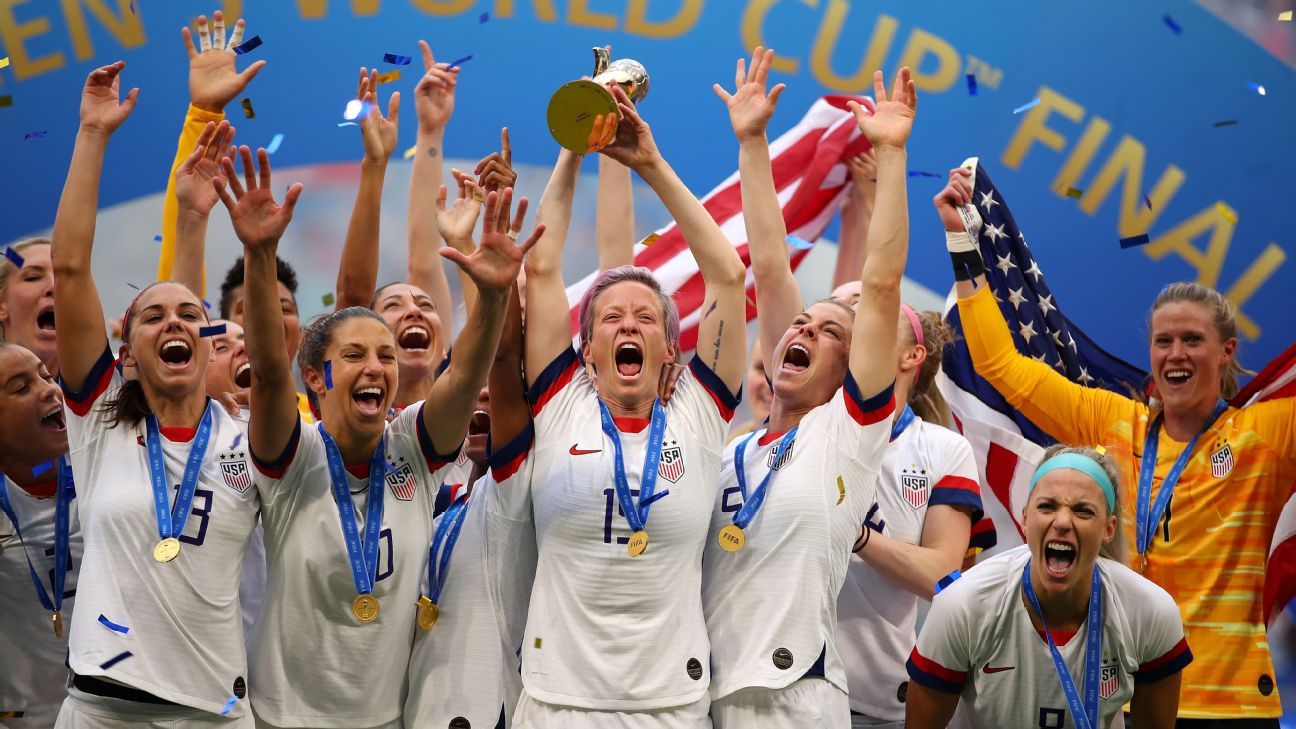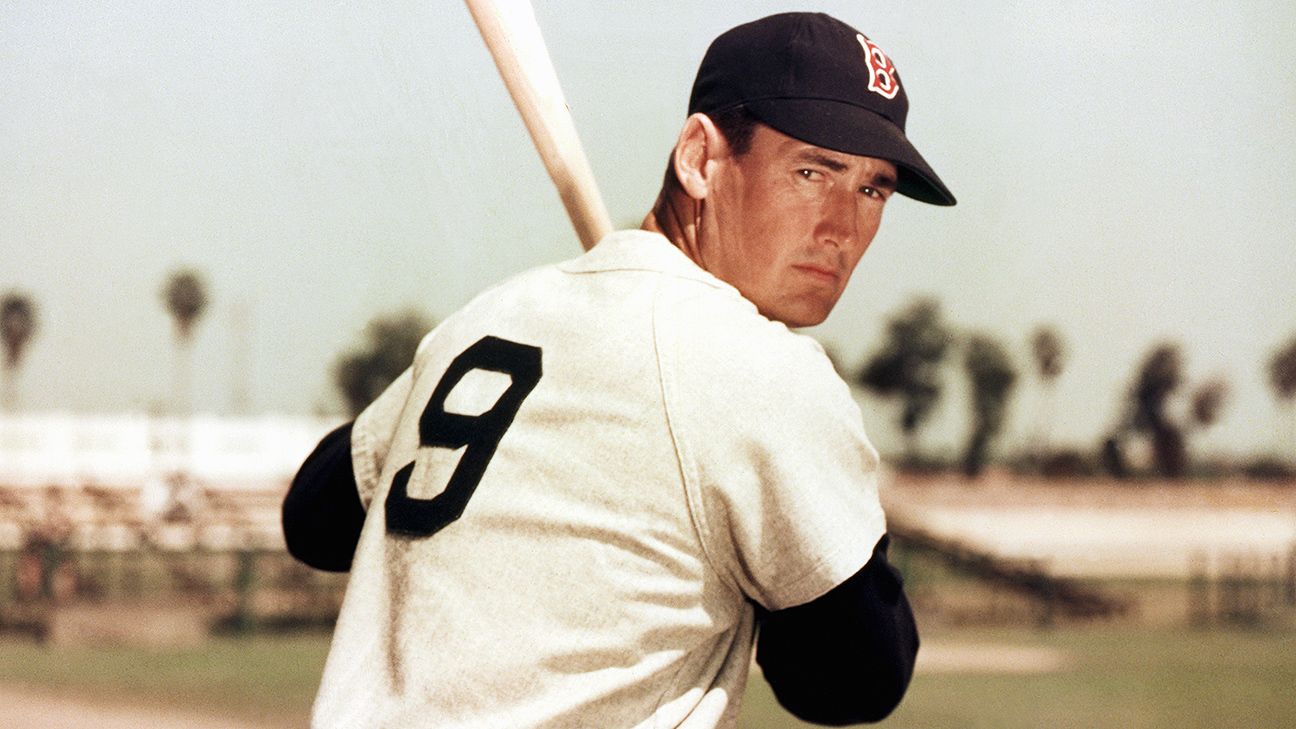
As we approach the one-year anniversary of the United States' victory in the 2019 FIFA Women's World Cup -- its second straight and fourth overall -- it is a good time to look back at how this team has come to top the sport and where its largest vulnerabilities lie moving forward.
Let's both study and celebrate a decade of dominance. To do this, I'll be calling on data from the past three World Cups plus other tournaments and recent friendlies at which Opta was collected.
Looking back
After allowing a 117th-minute goal to Homare Sawa and losing in a penalty shootout in the 2011 World Cup final, the U.S. ruled the rest of the decade. In two Olympics (plus qualification) and two World Cups (plus qualification), the USWNT won 37 matches, drew just twice and lost only once, in a 2016 Olympic quarterfinal shootout versus Sweden. It scored 170 goals in these matches (4.3 per match), allowed 15 goals (0.4 per match) and won the two World Cup finals by a combined 7-2. And since the SheBelieves Cup began in 2016, pitting four of the world's best teams in a round-robin competition, the U.S. has more titles (three) than losses (two).
• USWNT lawsuit versus U.S. Soccer explained
• Analysis: What equal pay in women's sports really means
• Complete coverage: U.S. women's national team
It is fair to say the U.S. dominates women's soccer to a degree unmatched by any team in men's soccer. How does that domination take shape on the stat sheet? In what areas of the game has this team asserted its superiority?
Shot quality
In the 2019 Women's World Cup, seven of 24 teams averaged at least 14 shot attempts per match. Six of them -- Canada, France, Germany, South Korea, Spain and Sweden -- averaged 16.2 shots and 1.5 goals per match. The seventh, the U.S., averaged 18.4 shots and 3.7 goals. The average goals-to-shots conversion rate in the tournament was 11.1%; the USWNT's was 20.2%. While the U.S. averaged 2.95 expected goals (XG) per match, it averaged 3.71 actual goals, a difference of +0.76, the highest in any of the past three World Cups.
That is probably unsustainably high. For one thing, this sample includes the team's 13-0 pasting of an overwhelmed Thailand. For another, while the difference between goals and XG is certainly part skill, it's also part randomness. Outliers will regress toward the mean. That said, it was also part of a trend. The U.S. enjoyed a +0.26 difference between goals and XG in 2015, too, and has been around +0.44 for other recent tournaments and friendlies.
To the extent that skill is at play instead of randomness, it comes down to shot quality. In 2011, 34% of the USWNT's shots were on target. In 2015 and 2019, it was 44%. In 2011, 60% of its shots were taken inside the box; in 2015, it was 72% and in 2019, 74%.
The combination of brilliant crossing and strong positioning from forwards such as Carli Lloyd, Alex Morgan and Mallory Pugh, with incredible long-distance accuracy from wingers like Megan Rapinoe and Tobin Heath, has given the U.S. the most consistent and deadly striking ability in the world.
Two other areas of play deserve mention here: crosses and set pieces.
Crosses can end up as a Hail Mary option when an attack hasn't produced anything better, but in the right hands -- say Rapinoe's, Heath's or Christen Press' -- they can be a direct route to success. The U.S. has slowed its use of crosses through the years -- from 25.4 per 90 minutes in the 2011 World Cup to 18.4 last year -- and simultaneously increased their effectiveness, from a 28% completion rate in 2011 to 34% in 2019. (The average completion rate at the 2019 World Cup was 25%.)
Over the past two years in a U.S. shirt, Rapinoe, Heath and Press have combined for a completion rate of 35% on crosses, with Crystal Dunn not far behind at 29%. In fewer attempts, Pugh (36%), Tierna Davidson (47%) and Lindsey Horan (46%) have also been deadly. Obviously it helps to have players the caliber of Lloyd and Morgan on the end of these passes, but the quality of service has been impeccable.
It's the same story with set pieces. Each of the past three World Cups produced an average of about 0.3 goals per match from set pieces; the U.S. improved its average from 0.3 in 2011 to 0.6 in 2015 to 0.9 in 2019. And it's the same cast of characters involved: Rapinoe, Heath and Press serve up the chances when a pass is required, and Horan (six goals from set pieces), Lloyd (five) and Morgan (three) finish them off.
Ball control
When you've got a team as talented and athletic as the U.S., a lot of management comes down to keeping the players motivated and getting them ready to scrap.
The current player pool is the scrappiest yet. Lavelle, Ertz, Dunn and Horan have all averaged between 7.1 and 7.3 ball recoveries per 90 minutes over the past two years (in a smaller sample of appearances, Morgan Brian has averaged 8.2), and the U.S. absolutely dominated loose balls at the most recent World Cup. Its plus-14.3 margin for ball recoveries per match was easily the best in France (second-best: France at +9.8).
The U.S. also created a lot of opportunities to collect loose balls. Despite teams rapidly improving in terms of possession play and ball control between 2011 and 2019, the U.S. won nearly as many balls in the attacking third last year as it had eight years earlier. And over the past two years, Heath, Rapinoe, Pugh, Sonnett and Brian have all averaged between 5.1 and 5.7 possessions won per 90 minutes in the attacking third.
The pressure often begins the moment you earn possession and never ceases. While 44% of U.S. possessions reached the attacking third in both 2015 and 2019, for opponents it was 33% in 2015 and 25% in 2019.
Goalkeeping
In a small sample, a team's save percentage can portend upcoming improvement or regression. If it's particularly high, it's going to fall (and vice versa), no matter your talent level.
That makes it pretty difficult to judge U.S. goalkeepers. Not only is the World Cup a small set of games to begin with, but American goalkeepers have rarely been challenged. Thanks to both defensive pressure and blocked shots, they faced the second-fewest shots on goal per match in 2019 and fourth fewest in 2015. Still, they've aced the tests they've been given. Alyssa Naeher recorded an 80% save percentage in the 2019 World Cup, while Hope Solo hit 75% in 2015 and 77% in 2011. The overall average was in the mid-to-high 60s in each tournament.
Looking at a larger sample of U.S. matches (tournaments and friendlies) from 2017 to 2020, the team's average save percentage was 74%. Even accounting for small samples and potential regression to the mean, it's safe to assume that U.S. goalkeeping has been, at worst, consistently above average.
Since this is an individual position and is therefore reliant on singular talents over depth of athleticism, it will be interesting to see if the pattern continues moving forward. Over the past three years, only three keepers have seen action in U.S. matches: 32-year-old Naeher, Ashlyn Harris (34) and Adrianna Franch (29). Maybe Naeher remains atop the depth chart through the next World Cup cycle, but if or when players like the Washington Spirit's/Sydney FC's Aubrey Bledsoe (28), the Houston Dash's Lindsey Harris (26) and Jane Campbell (25), OL Reign's Casey Murphy (24) or the Chicago Red Stars' Emily Boyd (23) become options, they'll have a high bar to clear.
Vulnerabilities
As good as the USWNT has been, we probably shouldn't pretend it is invulnerable. As rampant as the U.S. appeared for much of the 2019 World Cup, it was still tied with Spain in the 75th minute in the round of 16 before being granted a semi-controversial penalty kick. The USWNT was still outplayed by France for much of its high-profile quarterfinal matchup. And both England in the semifinals and France outdid the Americans from an XG perspective.
In other words, the U.S. still needed good fortune. Everyone does. But the competition was awfully tight at the top, and it will probably get only tighter moving forward.
The main reason? Ball control. Obviously the possession game isn't the only way to win in soccer -- holding on to the ball doesn't mean much if you don't get anything out of it -- but there's a reason why every rich club in men's soccer is trying to play it.
In the World Cup last summer, six teams possessed the ball a higher percentage of the time than the U.S. Looking only at games against teams that advanced to the knockout rounds (so, filtering out matches against teams like Thailand), the U.S. was ninth in possession. It was 12th in pass attempts per 90 minutes against this pool of teams. Its number of solo possessions increased compared to 2015, and its average passes per possession decreased.
While the defense remained excellent against all comers, the U.S. attack mostly vanished against the best teams in the tournament. France averaged 2.3 XG per match against knockout-round teams, but the U.S. averaged only 1.9. Its aerial and duel win percentages sank -- a sign that the Americans' physical dominance was wavering in some ways -- and the USWNT struggled to control games against other strong teams.
Mind you, the USWNT was still elite in the finishing department, still excellent at set pieces (like Rapinoe's strike that put the U.S. up on France), still brilliant at defending and goalkeeping (recall Naeher's late penalty save or Becky Sauerbrunn's goal-line clearance against England), still better than its opponents in terms of ball recoveries and still, by far, the most talented and athletic team.
While now-retired coach Jill Ellis was known far more for her elite player-management skills than her tactical brilliance, there are plenty of signs that certain nations, especially in Europe, are catching up. As the game continues its rapid advance, as investment continues to grow in other countries, as the player pool continues to grow more talented worldwide, and as the coaching also continues to develop, the tactical bar for winning big will likely continue to rise. We'll see what Ellis' successor, Vlatko Andonovski, has in store in that regard.















 Phone: (800) 737. 6040
Phone: (800) 737. 6040 Fax: (800) 825 5558
Fax: (800) 825 5558 Website:
Website:  Email:
Email: 






